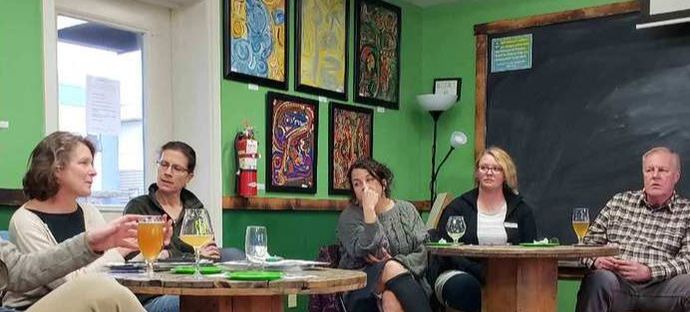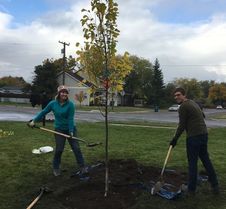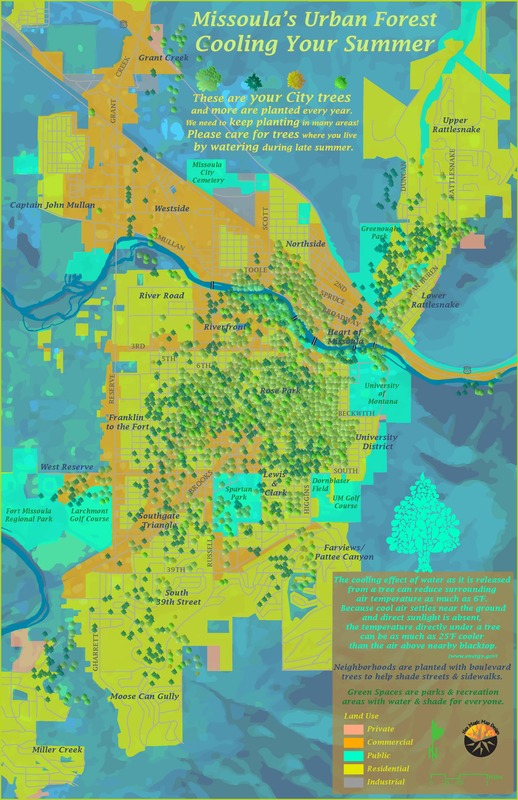 Let’s say you walk into a large Missoula park on a boiling hot summer day. You're hoping to have a picnic and are looking for some shade. You spy a large oak tree on the corner, casting a huge net of relife. You set up your blanket and enjoy a cool picnic in the shade. Can you imagine what your picnic would have been like without the surrounding trees? Trees provide so many benefits, cooling us off in the summer and providing a windbreak in the winter. They're invaluable to our water systems and air quality. Climate Smart Missoula's April monthly meetup was all about the importance of trees in our city, neighborhoods, and surrounding wildland forests. Dave Atkins came to speak about TreeSource, a new-ish website that "includes original stories, photo essays, videos and podcasts that take readers into North America’s forests and the cities that rely upon them for everything from drinking water and building materials to carbon storage, renewable energy, recreation and biodiversity.” Do check TreeSource out for the latest in forest journalism. Dave began by talking about the concept of biophilia. Like most in attendance, I’d never heard this term before. Biophilia is defined as “the recognition that human beings are wired towards nature.” Scientific studies have shown that humans work better while surrounded in nature or natural materials, such as wood buildings. Stress levels are brought down and productivity is proven to be significantly higher. More here. This rings true for me. As a student at UM, I've noticed the buildings at the University where I get the most work done are naturally lit with views of trees, rather than under the dim glow of the basement library lights. When I work near or outside my stress level decreases, creating a space where I can produce my best work. Back to the meetup. Representatives from the City of Missoula's Urban Forestry Division and Trees For Missoula spoke about the amazing work they do to maintain, enhance, and expand Missoula’s urban forest through pruning, planting and hazard removals. According to Trees for Missoula, the beautiful trees that line our streets, parks and homes were planted 80 years or more ago and most have life spans around 50-100 years, meaning it is essential to plant their replacements now. So how can folks get involved in enhancing and maintaining our urban forests? One important aspect of our urban forests maintenance is the work of volunteers. The Urban Forestry Division is fairly understaffed and currently on a 51 year pruning cycle. I was shocked to learn that for trees to be healthy, they should be on a 10-15 year pruning cycle! Even while understaffed, 400 trees were pruned this winter. Want to shorten the pruning cycle? Check out all the great ways to volunteer for Trees For Missoula here. As they explicitly say “No forestry or technical background is required, only a passion for enhancing and maintaining Missoula's trees". Also, don't forget to register for “Run for Trees” this Saturday, April 14 located at Silver Park, 900 Cregg Lane, Large Pavilion west of The Missoula Osprey's Ogren Park Allegiance Field. While we can volunteer and get involved directly in the maintenance and growth of our urban forest, it's still necessary to educate and advocate to fellow community members about the importance of trees. Many at our meeting spoke to the idea of advocating for a mandate on planting trees or green space in commercial development areas. Trees serve to cool the area, decreasing the Urban Heat Island affect and providing shade especially in the peak of summer. They benefit everyone in the community! Our group agreed that a great way to enhance our urban forest is to help people understand all the benefits of trees and the need to plant and water them. For more, check out this Sustainable Missoula piece Trees for Missoula's Karen Sippy. Finally, Urban and Wildland Forests is a focal area in our community's Climate Smart Action Plan, with strategies and more info here. At this meetup, I learned very quickly that there is a lot more to trees than you may think. They're wonderfully complex parts of our world that do so much good. They store carbon, make us happy and healthy, and create more aesthetically appealing streets. You may not have the time or skills to become a professional arborist, but we can all be advocates for maintaining, enhancing and expanding Missoula’s urban forest! - Sydney Lang, Climate Smart Intern
0 Comments
Leave a Reply. |
AuthorsAbby Huseth Archives
July 2024
Categories
All
|



 RSS Feed
RSS Feed


